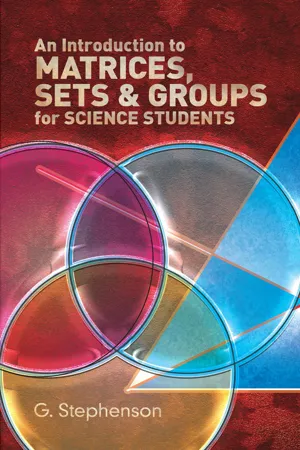
- 176 pages
- English
- ePUB (mobile friendly)
- Available on iOS & Android
An Introduction to Matrices, Sets and Groups for Science Students
About This Book
This outstanding text offers undergraduate students of physics, chemistry, and engineering a concise, readable introduction to matrices, sets, and groups. Concentrating mainly on matrix theory, the book is virtually self-contained, requiring a minimum of mathematical knowledge and providing all the background necessary to develop a thorough comprehension of the subject.
Beginning with a chapter on sets, mappings, and transformations, the treatment advances to considerations of matrix algebra, inverse and related matrices, and systems of linear algebraic equations. Additional topics include eigenvalues and eigenvectors, diagonalisation and functions of matrices, and group theory. Each chapter contains a selection of worked examples and many problems with answers, enabling readers to test their understanding and ability to apply concepts.
Frequently asked questions
Information
Table of contents
- Cover
- Title page
- Copyright
- Contents
- Preface
- 1. Sets, Mappings and Transformations
- 2. Matrix Algebra
- 3. The Inverse and Related Matrices
- 4. Systems of Linear Algebraic Equations
- 5. Eigenvalues and Eigenvectors
- 6. Diagonalisation of Matrices
- 7. Functions of Matrices
- 8. Group Theory
- Further Reading
- Answers to Problems
- Index